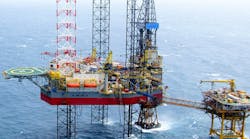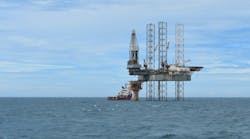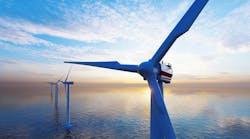Shell expects 1 billion boe from 140 wells
Frank Frazer
Contributing Editor - Scotland
- Heavy lifts were progressively reduced from 26 to 11 per platform through learning curve experience gained on the Brent redevelopment project.
- A new derrick set was com mis sioned for the Brent Charlie platform as part of the re-equip ping for the well engineering challenges which lie ahead.
- Work on the Brent Delta platform will complete the largest redevelopment project in North Sea history within schedule and below budget.
As the most ambitious redevelopment in North Sea history nears completion, Shell engineers are switching focus to subsurface challenges which must also be tackled successfully to maintain the Brent field as the UK's largest source of unrecovered hydrocarbons, despite more than 20 years of production.
Advanced drilling and completion technologies will be critical to meeting output and financial targets set to ensure operations remain viable at least until 2010. This compares with a prediction at startup in 1976 that the reservoir might be depleted as a commercial producer as early as next year.
Since the decision was made in 1993 to invest in extending field life, three of the four Brent platforms have been extensively re-equipped to convert to low-pressure operation, which will allow more of Brent's gas reserves, trapped in solution with remaining oil, to be recovered in the final stages of reservoir operation.
Pressure reduction
The gradual reduction in pressure will replace the water flooding which has been used to sweep out oil in the past. Injected water mixed with the field's natural aquifer will also eventually be drawn off to help further with the planned depressurization.In this way, Shell aims to recover more than 40% of the liquids and about 80% of the gas - yielding at least another 1 billion bbl oil equivalent (boe) from about 140 wells. This will put the field significantly ahead of the 830 million boe expected from the Morecambe gasfield as the UK's second largest known source of remaining recoverable reserves.
While the depressurization program is a major component in maximizing recovery from Brent, well engineering will also play an important part in reaching remaining pockets of oil and gas. Horizontal and extended reach drilling enable project teams to plan designer wells following whiplash trajectories which were unimaginable when the original pattern of reservoir drainage was devised in the 1970s within the constraints of deviated drilling techniques available at that time.
The planning process is aided by an elaborate modeling system which uses 160 layers and 70 million grid blocks to simulate reservoir performance from varying well configurations and the application of different production techniques. Even with the most powerful computers available commercially, it takes several weeks to crunch the data required to show remaining life-of-field predictions for each scenario put to the test.
Preparations for an extensive program of drilling, re-entries and workovers were included in the refurbishment plans for the Brent platforms launched in 1993. Rigs on all four platforms have been upgraded with top drive systems and the installation of Palfinger mechanized pipe-handling equipment.
New technology
The facilities enable drilling, controlled from consoles within enclosed cabins, to continue in adverse weather without any need for personnel on the drill floor during normal operations. Shell also decided to order an upgraded replacement derrick set for the Brent Charlie platform.With newer techniques such as coiled tubing promising cost-effective solutions to the well completion challenges presented by Brent, Shell engineers have spent considerable time over the last two years evaluating and running pilot tests on emerging technologies. As well as yielding useful experience which will aid further planning of Brent wells, the efforts have notched up some impressive firsts. These included what were at the time the longest offshore coiled tubing drilled well which penetrated 1,500 ft into Dunlin shales and the world's deepest coiled tubing drilled well which reached a total depth of 11,238 ft.
Work will continue on seeking innovative solutions to the challenges as part of a commitment by the Brent team to maintain "best-in-class" performance which will make it viable to develop all remaining recoverable reserves in the field. As part of the plan, a target has been set to reduce average well costs by 2002 to 50% of the 1994 level.
This will continue the progress which was made between 1993 and last year when average well costs fell from UKP9.2 million to UKP5.7 million. With the 1994 average calculated at UKP8.5 million, it suggests that only a further UKP1.5 million needs to be lopped off costs to reach the target.
The time spent drilling each has also been reduced progressively from an average duration of 117 days spent on each of five wells drilled without any horizontal sections in 1993, to 72 days last year when eight out of 10 wells drilled were horizontals.
Performance
In seeking to better subsurface performance, Shell hopes to capitalize on the continuous learning process which paid dividends during the complex topside redevelopment program. Most of the work was mainly concentrated on the concrete-built Bravo, Charlie, and Delta structures from which redundant modules were removed and replaced by new units and enhanced living quarters to ensure the installations conformed to latest safety standards as well as being re-equipped for low-pressure operation.The work on Bravo required 26 million manhours with 26 heavy lifts to position the components, resulting in a final cost of UKP439 million. From the experience gained, contractors were able to complete a similar redevelopment of the Charlie platform in 1.9 million manhours with 17 heavy lifts for a total cost of UKP363 million.
The bill for the redevelopment of the Delta platform, as the last structure to be tackled, is expected to work out at about UKP314 million after efforts to reduce manhours further to 1.1 million with the use of only 11 heavy lifts.
After adding other costs associated with the redevelopment, Shell executives expect the project to be completed at about UKP100 million below the original UKP1.3 billion budget agreed with Esso which has a 50% stake in the project. The savings take account of bonus payments paid to contractors for agreeing to share commercial risk in achieving project targets.
Copyright 1997 Oil & Gas Journal. All Rights Reserved.




